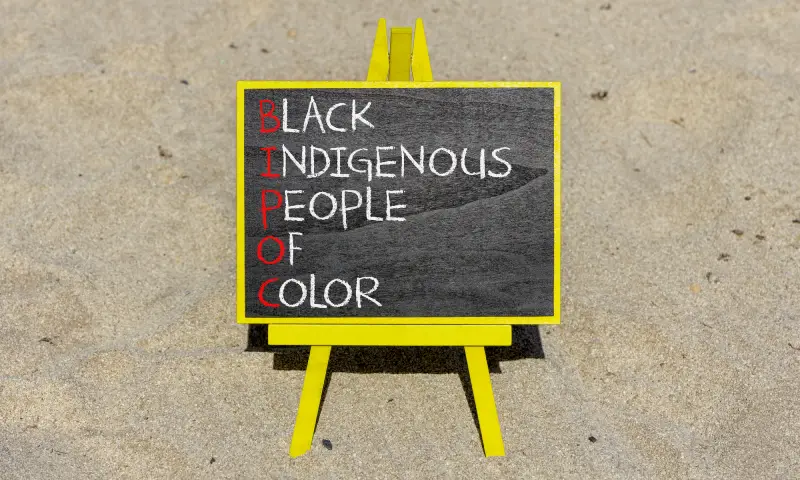Substance abuse in the United States leads to significant levels of preventable illness and premature death. According to the Substance Abuse and Mental Health Services Administration (SAMHSA)’s 2023 National Survey on Drug Use and Health report, approximately 48.5 million people or 17% of the U.S. population ages 12 and older had a substance use disorder during the previous year.
Among this number were 30 million people with alcohol use disorders, 27 million people with substance use disorders and 7.5 million people with both alcohol and substance use disorders.
Addiction affects people of all ethnicities and races but it disproportionately affects people in the BIPOC community. These are people who identify as Black, Indigenous or Persons of Color.
Nearby Rehab Centers for Mental Health
Finding facilities near you…
Understanding the BIPOC Community

People who identify as BIPOC can include African Americans, people from Caribbean countries (Black), Native Americans, Native Alaskan people (Indigenous), Asian and Pacific Islanders and Hispanic populations as well as others who are “non white” (ie: “people of color”).
The United States is home to people with a variety of racial, ethnic and cultural backgrounds. In July 2024 the United States Census Bureau performed a population survey and reported the percentages of different races that respondents identified as. These are the results:
- White: 58%
- Hispanic: 19.5%
- Black: 13.7%
- Asian: 6.4% *
- Multiracial: 3.1%
- American Indian or Alaska Native: 1.3%
One report from the UNC School of Medicine reveals that individuals identifying as BIPOC have additional burdens that may contribute to higher levels of substance abuse within their populations and that certainly contribute to additional barriers to treatment. Ethnic and racial minorities are more likely to have less stable employment, less stable housing and less reliable transportation than their non-minority counterparts.
These factors make it more difficult for minorities to find a rehab and they often result in higher levels of stress which is a known contributor to substance use. Other barriers to treatment include lack of insurance, lack of culturally sensitive treatment and cultural stigmas around substance misuse and treatment.
The Impact of Substance Abuse on the Black Community
A SAMHSA report found that almost 28% of Black individuals used illicit drugs in 2023 with marijuana being the most used substance. Fewer than 5% of this population used alcohol heavily.
The Black population includes individuals of African American and Caribbean descent. A 2022 SAMHSA study found that Black adults who experience mental health conditions are less likely to be treated for their conditions than white or multiracial adults.
Another 2024 study revealed possible reasons. More Black adults reported feeling that they were treated unfairly by healthcare providers than did white adults. For instance they were 10% more likely to report being denied a prescription for pain medication even though they felt they needed it. In addition 18% of Blacks vs. 3% of whites felt that their race or ethnic background caused them to be disrespected by a healthcare provider.
Black and African American Addiction and Mental Health Resources
BEAM
Standing for the Black Emotional and Mental Health Collective, BEAM is a national organization that provides in person and online resources including information on Black social justice and mental health campaigns. They also train mental health and social justice peer support providers.
NAMI
The National Alliance on Mental Illness or NAMI has a Black/African American resource area on its website. Here you can find information and resources including articles, book lists, educational videos and links to podcasts that support Black individuals and their mental health needs. There are also links to therapy providers who offer culturally sensitive care.
The Impact of Substance Abuse on Native American and Indigenous Peoples
Native American and Indigenous Peoples are individuals who belong to cultural groups that were among the original inhabitants of North America. This population includes people from American Indian and Alaskan Native groups. The population has a high rate of drug use disorder with about 20% reporting the use of illicit drugs in 2023. Marijuana was the most used substance with alcohol a close second. More than 23% of the Native American and Indigenous Peoples population had a mental illness other than or in addition to substance use disorder.
The CDC reports that drug overdose deaths were the highest among this population in 2022 and 2023 than among all other minority populations.
Factors that contribute to the high rate of substance abuse in the Native American and Indigenous Peoples population include high unemployment, poverty, lack of health insurance, discrimination, domestic violence and lower levels of education.
Native American and Indigenous Peoples Addiction and Mental Health Resources
Indian Health Service
The Indian Health Service is an agency within the U.S. Department of Health and Human Services. It’s responsible for providing federal health services to American Indians and Alaska Natives. Their website offers links to IHS hospitals, health clinics and dental and behavioral health facilities.
One Sky Center
One Sky Center is a resource center for American Indians and Alaska Natives nationwide. Their website offers information on health topics including addiction education in both article and PowerPoint format. There is also a link to access One Sky Center presentations on YouTube.com.
White Bison
This is a Native American nonprofit organization that facilitates addiction prevention programs, support group meetings and educational and cultural events for adults and teens. White Bison is based in Colorado but they also hold events in various locations nationwide. They sponsor Wellbriety Certified Substance Abuse Treatment Centers that feature culturally based treatment approaches and activities.
The Impact of Substance Abuse on the Hispanic and Latino Community
The Hispanic and Latino community is the largest non-white population in the U.S. with about 65.2 million people represented in this group. The 2023 SAMHSA report found that about 16% were diagnosed with a substance abuse disorder that year. However most of these people go untreated.
According to a national Latino research organization Salud America! up to 97% of the Latinos who refuse addiction treatment do so because they don’t feel ready for treatment and believe they can handle their substance use issues on their own.
In addition Latino people are among the most uninsured populations in the U.S. which can make treatment costs prohibitive. The growth of telehealth therapy has made treatment more accessible but barriers remain such as affordable and reliable access to the internet.
Hispanic and Latino Community Addiction and Mental Health Resources
Hispanic/Latino Behavioral Health Center of Excellence
Funded by the Substance Abuse and Mental Health Services Administration (SAMHSA), the Hispanic/Latino Behavioral Health Center of Excellence provides mental and behavioral health information and products tailored to the needs of Hispanic and Latino populations. This includes access to culturally-informed and linguistically-appropriate services for individuals and families. They also provide culturally-responsive training programs for clinicians and other healthcare providers.
The National LatinoBehavioral Health Association
National Latino Behavioral Health Association (NLBHA) addresses mental health and substance abuse in the Latino community and provides education and programs to promote behavioral health equity. Their website offers a free downloadable Mental Health Toolkit availablein eitherEnglish or Spanish as well as links to a crisis hotline and informational documents on topics of domestic violence prevention, marijuana use and other mental health issues.
The Impact of Substance Abuse on the QTBIPOC Community
QTBIPOC is an acronym for Queer and Trans Black, Indigenous and People of Color. It refers to sexuality and gender identity in addition to racial identity. A 2023 SAMHSA survey on underserved populations reported that between one-fourth and one-third of bisexual and gay individuals had a substance abuse disorder.People within this community often face stigma and discrimination. They are especially needful of alcohol and substance use treatment that incorporates culturally sensitive programming.
QTBIPOC Addiction and Mental Health Resources
CenterLink
CenterLink is a coalition of LGBTQ community centers. The website offers links to centers nationwide where LGBTQ individuals can access mental health services, programs and support groups.
The Center for Black Equity
This center promoteshealth and economic opportunities for black LGBTQ individuals nationwide and globally. The Center for Black Equity supports Black LGBTQA+ Pride events. The website provides a map of these global events.
The National Black Trans Advocacy Coalition
The National Black Trans Advocacy Coalition is a social justice organization for Black trans people. They sponsor conferences and offer support to Black trans individuals facing discrimination, using online chat or email communications.
The Impact of Substance Abuse on the Asian American and Pacific Islander Community
AAPI is an acronym that describes people of Asian American and Pacific Island (including Native Hawaiian) ancestry. SAMHSA reports that AAPI individuals within the BIPOC community have lower rates of alcohol and substance use disorder than other racial and ethnic groups. Yet they often avoid accessing addiction treatment when it is needed due to cultural stigmas about such care.
AAPI is a diverse population so multiple forms of culturally sensitive programming are needed to encourage members of this community to seek substance abuse treatment when it is needed.
Asian American and Pacific Islander Addiction and Mental Health Resources
National Asian Pacific American Families Against Substance Abuse
National Asian Pacific American Families Against Substance Abuse (NAPAFASA) is a non-profit organization providing substance abuse education and support for Asian Americans. Their website offers a newsletter, videos and printed educational material. Links to research on AAPI substance abuse as well as mental health PDFs are available for download.
Asian Counseling and Referral Service
The Asian Counseling and Referral Service is a nonprofit organization that links AAPI individuals with mental health resources and referrals to counselors of AAPI heritage who can offer culturally sensitive treatment. They’re based in New York and their directory also lists clinicians in other states who offer such services in person or online. Their website offers links to a blog and podcasts.
Addiction Centers That Treat Mental Health
Finding facilities near you…



